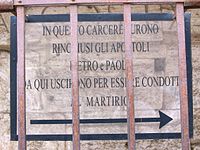- Mamertine Prison
-
 Silver Roman denarius, issued by the moneyer Lucius Hostilius Saserna at about 48 BC: obverse: noble Gaul with fibula and paludamentum. For someone, this coin might have depicted the real face of Vercingetorix, at the time captive in the Tullianum
Silver Roman denarius, issued by the moneyer Lucius Hostilius Saserna at about 48 BC: obverse: noble Gaul with fibula and paludamentum. For someone, this coin might have depicted the real face of Vercingetorix, at the time captive in the Tullianum
The Mamertine Prison (Carcere Mamertino) — or Tullianum — was a prison (carcer) located in the Forum Romanum in Ancient Rome. It was located on the northeastern slope of the Capitoline Hill, facing the Curia and the imperial fora of Nerva, Vespasian, and Augustus. Located between it and the Tabularium (record house) was a flight of stairs leading to the Arx of the Capitoline known as the Gemonian stairs.
The church of San Giuseppe dei Falegnami now stands above the Mamertine.[1]
Name
The origins of the prison's names are uncertain. The traditional derivation of "Tullianum" is from the name of one of the Roman kings Tullus Hostilius or Servius Tullius (the latter is found in Livy, Varro, and also Sallust); there is an alternative theory that it is from the archaic Latin tullius "a jet of water", in reference to the cistern. The name "Mamertine" is medieval in origin, and may be a reference to a nearby temple of Mars, or to Peter of the Bible.
History
The Prison was constructed around 640-616 BC, by Ancus Marcius. It was originally created as a cistern for a spring in the floor of the second lower level (there were two, the lower of which was where prisoners were kept by lowering them through the floor of the upper room), but eventually a passage between the cistern drain and the Cloaca Maxima was constructed, reputedly for flushing out dead bodies.
Typically, only higher profile prisoners were kept in the prison, usually foreign commanders such as Jugurtha who were defeated and became the centerpiece in a Roman triumphant procession. They usually remained incarcerated until they were paraded and strangled in public, unless they happened to die of natural causes first. (Roman law did not recognize imprisonment itself as punishment.) The prison was used in 63 BC to hold the members of the Second Catilinarian Conspiracy, including Publius Cornelius Lentulus Sura, just prior to their executions for their alleged plot to overthrow the Roman Republic. The Gallic chieftain Vercingetorix was imprisoned for 5 years and executed there in 46 BC.
It is not known when the prison went out of service permanently, but the site has been used for Christian worship since medieval times, and is currently occupied by two superimposed churches: S. Giuseppe dei Falegnami (upper) and S. Pietro in Carcere (lower). The Cross on the altar in the lower chapel is upside down, since according to tradition Saint Peter was crucified that way. The devil is said to have been appeared to Saint Peter and Saint Paul and their lives were changed forever after being in this prison.
References
- ^ The Roman Forum by David Watkin 2009 ISBN 0674033418 page 128
- Carcer ( Platner's Topographical Dictionary of Ancient Rome)
- Chapter Carcer in Hülsen's Foro Romano
- Catholic Encyclopedia on the prison and related Christian traditions
Coordinates: 41°53′36″N 12°29′04″E / 41.89333°N 12.48444°E
Categories:- Ancient city of Rome
- Roman law
- Defunct prisons in Italy
Wikimedia Foundation. 2010.


